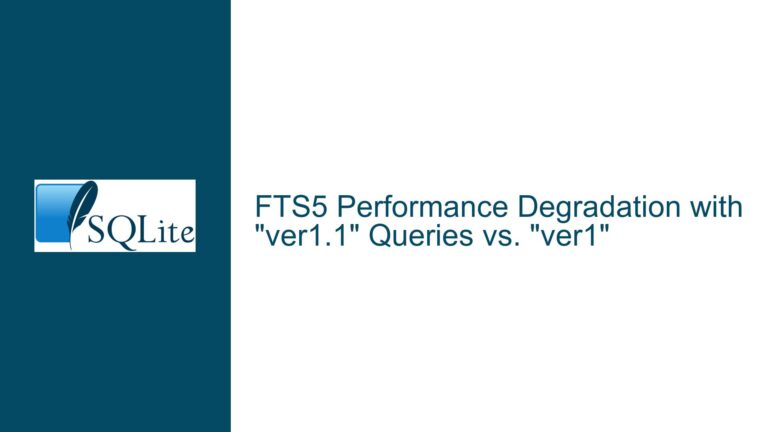Optimizing Index Selection for Read-Only SQLite Tables in Text Search Applications
Understanding the Query Patterns and Data Distribution
The core issue revolves around optimizing index selection for two read-only tables, eB_concordance and eBible, which are used in a text search application. The eB_concordance table contains approximately 800,000 rows, while the eBible table has around 31,000 rows. Both tables are expected to grow significantly as additional versions are added. The primary query involves searching for specific words within the eB_concordance table and then joining the results with the eBible table to retrieve the corresponding text. The query uses Common Table Expressions (CTEs) to handle multi-word searches, and the user is concerned about the efficiency of this approach and the selection of appropriate indexes.
The user has identified several key points that need to be addressed:
- The efficiency of the CTE approach, particularly when dealing with words that have varying frequencies.
- The determination of which columns should be indexed, including whether composite indexes should be used.
- The impact of specific column combinations on query performance, such as
version,book_no,chapter_no,verse_no, andword. - The potential impact of non-unique combinations of
book_no,chapter_no,verse_no, andindex_noon index effectiveness. - The handling of slightly different spellings of names within the same version and across different versions.
Analyzing the Impact of Word Frequency and CTE Efficiency
The user has observed that the frequency of words in the eB_concordance table varies significantly. For example, common words like "the" may appear over 50,000 times, while less common words like "faith" may appear only 247 times. This variation in word frequency can have a significant impact on the efficiency of the CTE approach. When searching for multiple words, the order in which the words are processed can affect the number of rows that need to be scanned. Starting with the least frequent word can reduce the number of rows that need to be processed in subsequent CTEs, thereby improving query performance.
The user has also raised the question of whether the CTE approach is the most efficient method for handling multi-word searches. While CTEs can be useful for breaking down complex queries into more manageable parts, they may not always be the most efficient approach, especially when dealing with large datasets. In some cases, alternative approaches, such as using temporary tables or subqueries, may offer better performance. However, the effectiveness of these alternatives depends on the specific query patterns and the distribution of data within the tables.
Determining the Optimal Index Strategy
The user has identified several columns that are frequently used in queries, including version, book_no, chapter_no, verse_no, and word. The question is whether an index on these columns in combination would always be used by the query optimizer. The answer depends on the specific query patterns and the distribution of data within the tables. In general, composite indexes can be effective when the columns in the index are used together in queries. However, the order of the columns in the index is important, as the index can only be used efficiently if the query conditions match the prefix of the index.
The user has also raised concerns about the impact of non-unique combinations of book_no, chapter_no, verse_no, and index_no on index effectiveness. While non-unique combinations can reduce the selectivity of the index, they may still be useful if the query conditions are selective enough. For example, if the query conditions narrow down the results to a small subset of rows, the index can still be effective in reducing the number of rows that need to be scanned.
Addressing the Impact of Slightly Different Spellings
The user has noted that some names occur with slightly different spellings within the same version and across different versions. This can complicate the search process, as the query needs to return all verses in which any of the spellings occur. The user has considered modifying the eB_concordance table to include all combinations for each spelling, but this approach may reduce the uniqueness of the index and affect its effectiveness. An alternative approach is to use a separate table to map different spellings to a common identifier, which can then be used in the search query. This approach can help maintain the uniqueness of the index while still allowing for flexible searches.
Implementing and Testing the Index Strategy
To determine the optimal index strategy, the user should start by analyzing the query patterns and the distribution of data within the tables. The .expert command in the SQLite CLI can be used to get recommendations on which indexes to create based on the specific queries being run. The user should also consider using the EXPLAIN QUERY PLAN statement to analyze the execution plan of the queries and identify any potential bottlenecks.
Once the indexes have been created, the user should test the performance of the queries using realistic data and query patterns. This testing should include both single-word and multi-word searches, as well as searches that involve different combinations of columns. The user should also monitor the performance of the queries as the size of the tables grows, to ensure that the indexes remain effective.
Conclusion
Optimizing index selection for read-only tables in a text search application requires a thorough understanding of the query patterns and the distribution of data within the tables. The user should consider the frequency of words, the selectivity of the query conditions, and the impact of non-unique combinations on index effectiveness. By carefully analyzing these factors and testing the performance of the queries, the user can determine the optimal index strategy and ensure that the application performs efficiently as the size of the tables grows.






